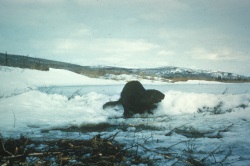
Sleeping on Sunflower
Courtesy and
Copyright © 2010 Jim Cane
The industry and cooperation of honeybees have inspired many a philosopher and society, including the Mormons who settled along the Wasatch front. The hive, or more specifically a skep, was later chosen as the emblem for the new state of Utah. But the honeybee, like it’s pioneer admirers, is a recent European immigrant, brought over for the wax and honey that colonies produce.
Utah did not lack for pollinators, however, prior to European settlement. More than 1000 species of native bees inhabit Utah, with several hundred species in any given county. A few of these bees — bumblebees and sweat bees — are social. They produce annual colonies headed by a queen. However, the vast majority of our bees are not social. For these, each adult female makes her own nest with no help from her sisters or mate.
Most solitary bee species nest underground; others use old beetle burrows in deadwood. The resident female subdivides her tunnel into bee-sized cavities. Each cavity receives a cache of pollen moistened with nectar and a single egg. There each grub-like larva will feed and develop in solitude. Most solitary bees will spend the winter here in their natal home.

Foraging on Hedysarum
Courtesy and
Copyright © 2008 Jamie Strange
Native bees pollinate many of Utah’s wildflowers, doing so inadvertently as they busily gather pollen for their progeny. Many solitary bee species are taxonomic specialists, focusing all of their pollen foraging efforts on one or a few related genera of flowering plants. Some common hosts for specialist bees in Utah include squashes, sunflowers, globemallows and penstemons. Sweet honey does not result from the labors of solitary bees, but fruits and seeds do. The industry of Utah’s native bees merits our attention and admiration.
This is Linda Kervin for Bridgerland Audubon Society.
Credits:
Text: Jim Cane, Bridgerland Audubon Society
Additional Reading:
USDA-ARS Pollinating Insects – Biology, Management and Systematics Laboratory, https://www.ars.usda.gov/main/site_main.htm?modecode=54-28-05-00
Crop domestication facilitated rapid geographical expansion of a specialist pollinator, the squash bee Peponapis pruinosa, Margarita M. López-Uribe, James H. Cane, Robert L. Minckley, Bryan N. Danforth
Proc. R. Soc. B 2016 283 20160443; DOI: 10.1098/rspb.2016.0443. Published 22 June 2016https://rspb.royalsocietypublishing.org/content/283/1833/20160443.abstract
Hager, Rachel, Bees, Bees And More Bees! Researchers Find Over 650 Bee Species In Grand Staircase-Escalante, UPR-Utah Public Radio, Nov 20, 2018, https://www.upr.org/post/bees-bees-and-more-bees-researchers-find-over-650-bee-species-grand-staircase-escalante
Bumblebee Watch, https://www.bumblebeewatch.org/
Bumble Bee Watch is a citizen science project through the partnership of The Xerces Society, the University of Ottawa, Wildlife Preservation Canada, BeeSpotter, The Natural History Museum, London, and the Montreal Insectarium.







